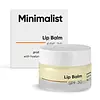What's inside
What's inside
 Key Ingredients
Key Ingredients

 Benefits
Benefits

 Concerns
Concerns

 Ingredients Side-by-side
Ingredients Side-by-side

Petrolatum
EmollientHydrogenated Polyisobutene
EmollientDiisopropyl Adipate
EmollientPropylene Glycol Dicaprylate/Dicaprate
EmollientC12-15 Alkyl Benzoate
AntimicrobialDiisopropyl Sebacate
EmollientMicrocrystalline Wax
Emulsion StabilisingC18-38 Alkyl Hydroxystearoyl Stearate
EmollientPersea Gratissima Butter
Skin ConditioningDiethylamino Hydroxybenzoyl Hexyl Benzoate
UV FilterCetearyl Alcohol
EmollientCeteareth-20
CleansingBehenyl Alcohol
EmollientNeopentyl Glycol Diheptanoate
EmollientPropylene Glycol Dibenzoate
Skin ConditioningCera Alba
EmollientEthylhexyl Triazone
UV AbsorberButyrospermum Parkii Butter
Skin ConditioningEuphorbia Cerifera Cera
AstringentOzokerite
Emulsion StabilisingTocopheryl Acetate
AntioxidantSodium Hyaluronate
HumectantBis-Ethylhexyloxyphenol Methoxyphenyl Triazine
Skin ConditioningCeramide NP
Skin ConditioningDiisostearyl Malate
EmollientEthylhexyl Palmitate
EmollientTrihydroxystearin
Skin ConditioningAmorphophallus Konjac Root Powder
AbrasiveBHT
AntioxidantPetrolatum, Hydrogenated Polyisobutene, Diisopropyl Adipate, Propylene Glycol Dicaprylate/Dicaprate, C12-15 Alkyl Benzoate, Diisopropyl Sebacate, Microcrystalline Wax, C18-38 Alkyl Hydroxystearoyl Stearate, Persea Gratissima Butter, Diethylamino Hydroxybenzoyl Hexyl Benzoate, Cetearyl Alcohol, Ceteareth-20, Behenyl Alcohol, Neopentyl Glycol Diheptanoate, Propylene Glycol Dibenzoate, Cera Alba, Ethylhexyl Triazone, Butyrospermum Parkii Butter, Euphorbia Cerifera Cera, Ozokerite, Tocopheryl Acetate, Sodium Hyaluronate, Bis-Ethylhexyloxyphenol Methoxyphenyl Triazine, Ceramide NP, Diisostearyl Malate, Ethylhexyl Palmitate, Trihydroxystearin, Amorphophallus Konjac Root Powder, BHT
Ricinus Communis Seed Oil
MaskingParaffin
PerfumingCera Alba
EmollientCetyl Palmitate
EmollientEthylhexyl Methoxycinnamate
UV AbsorberCetearyl Alcohol
EmollientIsopropyl Myristate
EmollientCetyl Alcohol
EmollientCandelilla Cera
EmollientCera Microcristallina
Emulsion StabilisingBisabolol
MaskingIsopropyl Palmitate
EmollientIsopropyl Laurate
EmollientStearic Acid
CleansingPalmitic Acid
EmollientPropylene Glycol
HumectantSodium Cetearyl Sulfate
CleansingSodium Sulfate
Citric Acid
BufferingBHA
AntioxidantBHT
AntioxidantParfum
MaskingRicinus Communis Seed Oil, Paraffin, Cera Alba, Cetyl Palmitate, Ethylhexyl Methoxycinnamate, Cetearyl Alcohol, Isopropyl Myristate, Cetyl Alcohol, Candelilla Cera, Cera Microcristallina, Bisabolol, Isopropyl Palmitate, Isopropyl Laurate, Stearic Acid, Palmitic Acid, Propylene Glycol, Sodium Cetearyl Sulfate, Sodium Sulfate, Citric Acid, BHA, BHT, Parfum
Alternatives
Ingredients Explained
These ingredients are found in both products.
Ingredients higher up in an ingredient list are typically present in a larger amount.
BHT is a synthetic antioxidant and preservative.
As an antioxidant, it helps your body fight off free-radicals. Free-radicals are molecules that may damage your skin cells.
As a preservative, it is used to stabilize products and prevent them from degrading. Specifically, BHT prevents degradation from oxidation.
The concerns related to BHT come from oral studies; this ingredient is currently allowed for use by both the FDA and EU.
However, it was recently restricted for use in the UK as of April 2024.
Learn more about BHTCera alba is beeswax, or the wax used by bees to make honeycombs. It is a texture-enhancer and emollient. A study from 2003 found beeswax to be a stronger emollient than ingredients such as petroleum jelly.
As an emollient, beeswax helps hydrate the skin by creating a barrier on top. This barrier traps moisture in.
Emulsifiers help prevent ingredients from separating. This helps create consistent texture.
The structure of beeswax is mainly long-chain alcohols and the esters of fatty acids.
There are three types of beeswax: yellow, white, and absolute. Yellow is pure beeswax taken from the honeycomb. White beeswax is created by filtering or bleaching yellow beeswax. Absolute beeswax is created by treating beeswax with alcohol. Beeswax used in cosmetics are purified.
Beeswax has been used throughout history and even in prehistoric times. Some common uses for beeswax still used today are making candles, as a waterproofing agent, and polish for leather.
Learn more about Cera AlbaCetearyl alcohol is a mixture of two fatty alcohols: cetyl alcohol and stearyl alcohol. It is mainly used as an emulsifier. Emulsifiers help prevent the separation of oils and products. Due to its composition, it can also be used to thicken a product or help create foam.
Cetearyl alcohol is an emollient. Emollients help soothe and hydrate the skin by trapping moisture.
Studies show Cetearyl alcohol is non-toxic and non-irritating. The FDA allows products labeled "alcohol-free" to have fatty alcohols.
This ingredient is usually derived from plant oils such as palm, vegetable, or coconut oils. There is debate on whether this ingredient will cause acne.
Due to the fatty acid base, this ingredient may not be Malassezia folliculitis safe.
Learn more about Cetearyl Alcohol